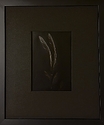James Drukeli
Member
I'm trying to make an etching plate from a black and white drawing which requires a film positive to burn the plate.
Since they no longer make 8x10 black and white slide film, is it possible to take a photo of the illustration using 8x10 color slide film (since the illustration is only black charcoal on white paper) and then use it to burn the plate?
Since they no longer make 8x10 black and white slide film, is it possible to take a photo of the illustration using 8x10 color slide film (since the illustration is only black charcoal on white paper) and then use it to burn the plate?












